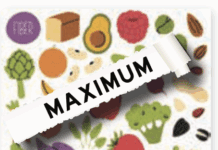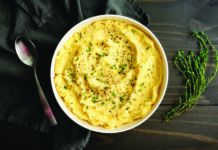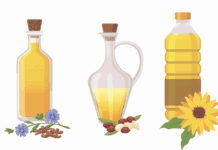If you have (or want to avoid) high blood pressure, limiting your intake of sodium is key. The main source of sodium in the diet is salt—but cutting salt can cut flavor. Fortunately, there are a seemingly endless variety of flavorful herbs and spices that are readily available to kick up the flavor in your food. Once you get a taste of what herbs and spices can bring to your plate (and your palate), it will be easy to cut back on salt.
Seasonings 101. The terms herbs and spices (collectively referred to as seasonings) are frequently used interchangeably, but they are not the same. Herbs are the leaves or other green parts of plants. Basil, thyme, oregano, and dill are common examples. They may be used fresh or dried. Now is the best time of year to enjoy fresh herbs from your backyard, windowsill, or local market. If you don’t have fresh herbs, you can substitute one teaspoon of dried herbs or one-quarter to one-half teaspoon ground herbs for every tablespoon of chopped fresh.
Spices come from the roots, bark, buds, seeds, berries, or fruit of plants and trees. Black pepper, cinnamon, turmeric, and paprika are common examples. Dried onion and garlic flakes or powder are also used as spices.
Brilliant Blends. Seasonings work well individually or in combinations. There are infinite pairings to complement any dish. If you’re buying pre-made seasoning blends, check labels to see if salt is included. It is best to choose salt-free or lower sodium options. Try these blends:
➧ Chili powder: A classic flavor from Mexican cooking popular throughout the U.S., this mix of paprika, oregano, cumin, garlic powder, onion powder, and cayenne powder is great in tacos, fajitas, bean dishes, chilis, and sauces. The level of hotness can vary.
➧ Italian: This mix, traditionally including basil, oregano, rosemary, marjoram, and thyme, is frequently used in tomato sauces, soups, roasted vegetables, egg dishes, salad dressings, and marinades.
➧ Herbes de Provence: Try this blend of rosemary, fennel seed, thyme, marjoram, parsley, oregano, tarragon, and lavender from France on grilled fish and poultry, with roasted root vegetables, or in ratatouille.
➧ Garam masala: Indian cuisine gives us this blend of cumin, coriander, cardamom, black pepper, cinnamon, cloves, and nutmeg. Use it in dry rubs for meat and poultry or in Indian dishes like chicken tikka masala and biryani.
Savvy Saves. Fresh herbs are in season now, but if you don’t use them right away you can freeze or dry them for a no-waste, easy way to keep bringing on the flavor no matter the season.
To freeze, wash herb sprigs and allow them to air dry. Place them in a single layer on a baking sheet and freeze, then transfer to an airtight container and keep frozen for up to six months. For use in soups, stews, and sauces, place chopped herbs into ice cube trays and cover with water. Once frozen, store cubes in airtight containers. Or mix minced herbs with a little water and freeze flat in a zip lock bag with the air squeezed out. Then break off pieces as needed. Use the same amount of frozen herbs as you would fresh in recipes.
To dry, tie sturdy herbs (like rosemary, sage, parsley, or thyme) into bunches and hang them upside down by the stems in a dry area with good air circulation. They take one to two weeks to dry at room temperature. Herbs may also be oven dried by removing the leaves from the stems and heating them in a single layer on a shallow baking sheet at 110 to 130 degrees Fahrenheit for about three to four hours. Be careful not to let them burn! Air dried or oven dried herbs are done when the leaves are crisp and crumbly. They will keep their flavor and color about three months in jars or airtight container in a cool, dry, dark place, or up to a year in the refrigerator or freezer.
Fresh and dried, herbs and spices bring unique flavors and fragrance to foods. They also enhance flavors without the need to add as much (or any) salt. Who said healthy needs to be bland?
➧ Cut the Salt. Lowering sodium intake by limiting the use of salt helps control or avoid high blood pressure. Experiment with using herbs and spices to replace some (or all) of the salt in your food.
➧ Try Fresh Herbs. This is the season when fresh herbs abound. Swap out a dried version with fresh (3:1 fresh to dried ratio) and savor the difference in flavor.
➧ Pair and Blend. Tasty combinations of herbs and spices bring foods to the next level of flavor. Experiment with simple pairings and sophisticated blends. Customize to your and your household’s preferences.
➧ Save Them. Dry or freeze fresh herbs to use all year long.





















